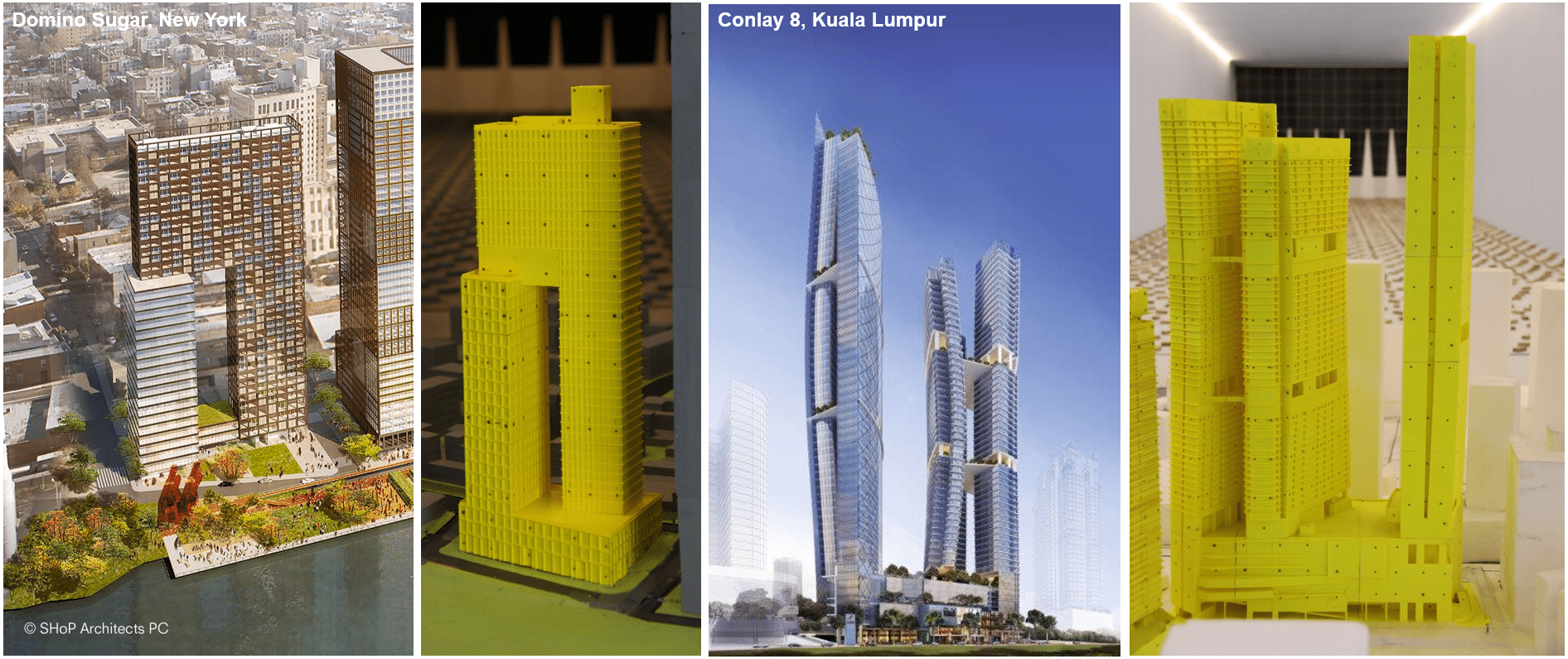How To Reduce The Cost Of Construction By 10-20% Without Impacting Quality.
Posted on April 28, 2023
Large construction projects are challenging enough without having to now navigate the recent increases in the cost of materials and labour. The cost of construction is one of the biggest challenges that developers face today, especially given the current global economic conditions. However, there is a little-known solution that can help to reduce the cost of construction typically in the order of 10-20% without impacting the design or quality of the building. The solution is performance-based wind design, specifically through wind tunnel testing and the adoption of advanced data analysis and probabilistic methods, which can help in further optimise the design of structure and façade, reduce material waste, and improve sustainability, all of which has a material impact on reducing embodied carbon associated with a project.

Figure 1. Sample Projects Tested in Windtech’s Boundary Layer Wind Tunnel
The prescriptive code-based design approach can be limiting, as it does not allow for flexibility and innovation. It also does not consider the specific wind loads and environmental factors that a building may encounter in its context. Hence the various committees that govern code content deliberately make them conservative and limit their scope to the typical building.
Wind tunnel testing is by its nature a performance-based design tool that provides an alternative option to the code-based design approach. It is a process that involves placing a scale model of an “as-designed” building in a wind tunnel within a model of the surrounding buildings, simulating the wind flow for multiple wind angles, and post-processing the data to determine full scale loads on structure and cladding. It does not need to adopt unnecessary levels of conservatism as it tries to produce wind effects that represent reality. However not all wind consultants are the same, as they adopt different methods for loads on structure and cladding, in addition to assessing the building performance under normal serviceability conditions. This aspect alone can make the difference between a 10% or 20% construction cost saving.
Aaron Lefcovitch, a Director of Windtech based out of the Singapore office explains “When, on occasion, the response of a building or structure to wind action has been compared between two of more wind consultants, it has been noted that a major source of difference has often turned out to be the way the wind consultant deals with directionality. Several methods have been proposed to deal with directionality, however some of these methods which are widely used, have significant limitations that could result in substantially under or over predicting the wind loads on the structural system or facade cladding. Windtech uses the multi-sector method (for more information see: Directionality: A key source of discrepancy between the results of Wind Consulting Companies | LinkedIn) which has been recognised by the ASCE Manual of Practice No. 143 (Design and Performance of Tall Buildings in Wind) as being the most sophisticated method of accounting for directionality with the least amount of approximation (and conservatism). Windtech is the first wind engineering firm to implement the more rigorous multi-sector analysis technique more than a decade ago. In doing so, we have been doing our part by bringing advanced technologies to the market which have a material impact on cost, design efficiency and sustainability, though the use of more pure performance-based design methods. Applying the latest advances in the wind engineering industry remains to be one of the core focuses of the team at Windtech, and we continue to develop these technologies on an ongoing basis to serve our clients”

Figure 2. Sample Projects Tested by Windtech
Wind tunnel testing is a useful tool for tall building design because it provides crucial information on how a building will respond to wind loads, particularly under normal serviceability wind conditions. Codes and Standards often require buildings to meet specific criteria for deflection and acceleration, and if these criteria are exceeded, additional costly structural rework or auxiliary devices like dampers may be required to bring the building accelerations within permissible limits. Wind tunnel testing also ensures that some of these costly measures are not implemented into a building unnecessarily. In combination with Windtech’s advanced multi-sector method we can assist the design team in eliminating the unnecessary costs, allowing the opportunity to optimise the structural design and minimize material waste and/or damping systems that may in fact not be required. This all has a material impact on also reducing the risk of costly delays which would also impact a projects bottom line, assuming the building does not comply from a performance point of view.

Figure 3. Sample Special Projects Tested by Windtech
Tony Rofail, a Director of Windtech based out of the Sydney office adds that “wind tunnel studies generally result in 10-15% reduction is cost of a major development up to lockup stage (façade and structure). However, a study conducted of over 55 typical tall building projects indicated that the more rigorous Multi-Sector analysis technique was not only more accurate from a loads and dynamic responses point of view, but in fact resulted in an additional 5-10% saving in the cost of the structure and façade. Even greater savings can be achieved for the very tall or slender developments (however many of these would tend to fall outside of the scope of wind loading standards anyway). A small investment in the use of rigorous techniques pays significant dividends down the track, and we are not talking 10% or 20% – it is typically in the order of 2,000% to 5,000%!. This is why the more successful developers don’t think twice about commission Windtech”
If you are working on any projects that could benefit from the capabilities presented in this article, please reach out to our regional office via our Contact Us page.
To get regular updates on news and events, please follow us on our LinkedIn page.
Return to Main News Page

